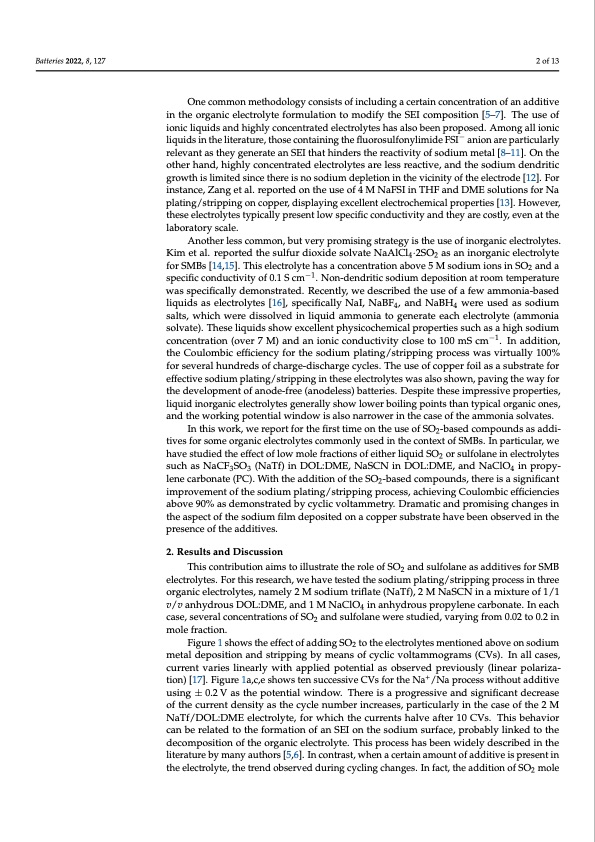
PDF Publication Title:
Text from PDF Page: 002
Batteries 2022, 8, 127 2 of 13 One common methodology consists of including a certain concentration of an additive in the organic electrolyte formulation to modify the SEI composition [5–7]. The use of ionic liquids and highly concentrated electrolytes has also been proposed. Among all ionic liquids in the literature, those containing the fluorosulfonylimide FSI− anion are particularly relevant as they generate an SEI that hinders the reactivity of sodium metal [8–11]. On the other hand, highly concentrated electrolytes are less reactive, and the sodium dendritic growth is limited since there is no sodium depletion in the vicinity of the electrode [12]. For instance, Zang et al. reported on the use of 4 M NaFSI in THF and DME solutions for Na plating/stripping on copper, displaying excellent electrochemical properties [13]. However, these electrolytes typically present low specific conductivity and they are costly, even at the laboratory scale. Another less common, but very promising strategy is the use of inorganic electrolytes. Kim et al. reported the sulfur dioxide solvate NaAlCl4·2SO2 as an inorganic electrolyte for SMBs [14,15]. This electrolyte has a concentration above 5 M sodium ions in SO2 and a specific conductivity of 0.1 S cm−1. Non-dendritic sodium deposition at room temperature was specifically demonstrated. Recently, we described the use of a few ammonia-based liquids as electrolytes [16], specifically NaI, NaBF4, and NaBH4 were used as sodium salts, which were dissolved in liquid ammonia to generate each electrolyte (ammonia solvate). These liquids show excellent physicochemical properties such as a high sodium concentration (over 7 M) and an ionic conductivity close to 100 mS cm−1. In addition, the Coulombic efficiency for the sodium plating/stripping process was virtually 100% for several hundreds of charge-discharge cycles. The use of copper foil as a substrate for effective sodium plating/stripping in these electrolytes was also shown, paving the way for the development of anode-free (anodeless) batteries. Despite these impressive properties, liquid inorganic electrolytes generally show lower boiling points than typical organic ones, and the working potential window is also narrower in the case of the ammonia solvates. In this work, we report for the first time on the use of SO2-based compounds as addi- tives for some organic electrolytes commonly used in the context of SMBs. In particular, we have studied the effect of low mole fractions of either liquid SO2 or sulfolane in electrolytes such as NaCF3SO3 (NaTf) in DOL:DME, NaSCN in DOL:DME, and NaClO4 in propy- lene carbonate (PC). With the addition of the SO2-based compounds, there is a significant improvement of the sodium plating/stripping process, achieving Coulombic efficiencies above 90% as demonstrated by cyclic voltammetry. Dramatic and promising changes in the aspect of the sodium film deposited on a copper substrate have been observed in the presence of the additives. 2. Results and Discussion This contribution aims to illustrate the role of SO2 and sulfolane as additives for SMB electrolytes. For this research, we have tested the sodium plating/stripping process in three organic electrolytes, namely 2 M sodium triflate (NaTf), 2 M NaSCN in a mixture of 1/1 v/v anhydrous DOL:DME, and 1 M NaClO4 in anhydrous propylene carbonate. In each case, several concentrations of SO2 and sulfolane were studied, varying from 0.02 to 0.2 in mole fraction. Figure 1 shows the effect of adding SO2 to the electrolytes mentioned above on sodium metal deposition and stripping by means of cyclic voltammograms (CVs). In all cases, current varies linearly with applied potential as observed previously (linear polariza- tion) [17]. Figure 1a,c,e shows ten successive CVs for the Na+/Na process without additive using ± 0.2 V as the potential window. There is a progressive and significant decrease of the current density as the cycle number increases, particularly in the case of the 2 M NaTf/DOL:DME electrolyte, for which the currents halve after 10 CVs. This behavior can be related to the formation of an SEI on the sodium surface, probably linked to the decomposition of the organic electrolyte. This process has been widely described in the literature by many authors [5,6]. In contrast, when a certain amount of additive is present in the electrolyte, the trend observed during cycling changes. In fact, the addition of SO2 molePDF Image | Sulfur Dioxide and Sulfolane Sodium Batteries

PDF Search Title:
Sulfur Dioxide and Sulfolane Sodium BatteriesOriginal File Name Searched:
batteries-08-00127-v2.pdfDIY PDF Search: Google It | Yahoo | Bing
Salgenx Redox Flow Battery Technology: Salt water flow battery technology with low cost and great energy density that can be used for power storage and thermal storage. Let us de-risk your production using our license. Our aqueous flow battery is less cost than Tesla Megapack and available faster. Redox flow battery. No membrane needed like with Vanadium, or Bromine. Salgenx flow battery
| CONTACT TEL: 608-238-6001 Email: greg@salgenx.com | RSS | AMP |